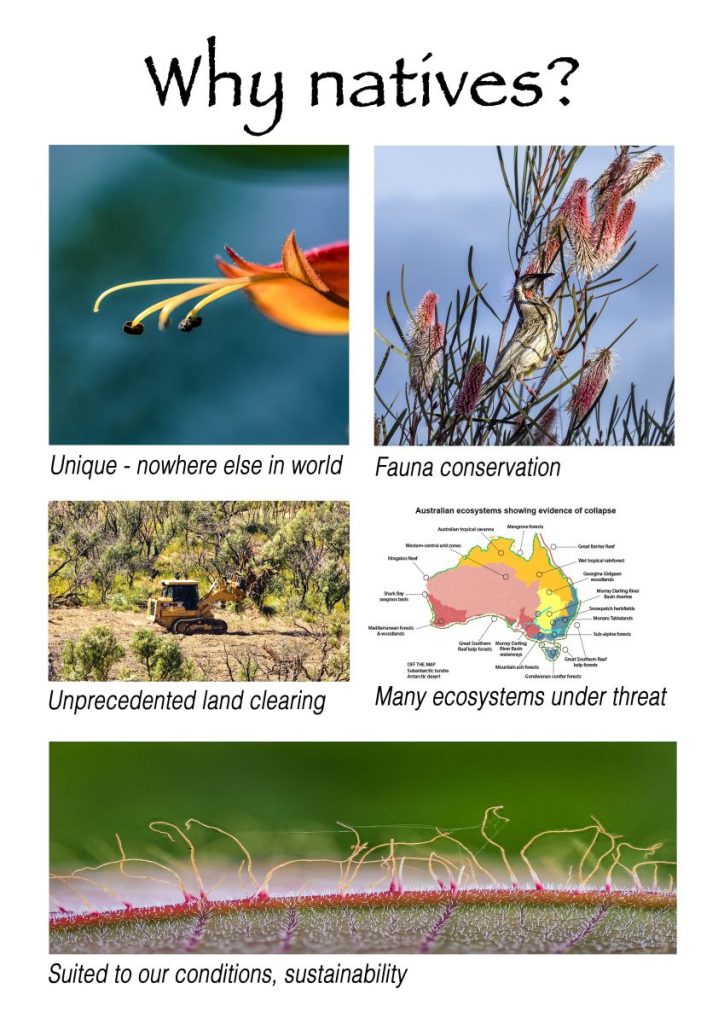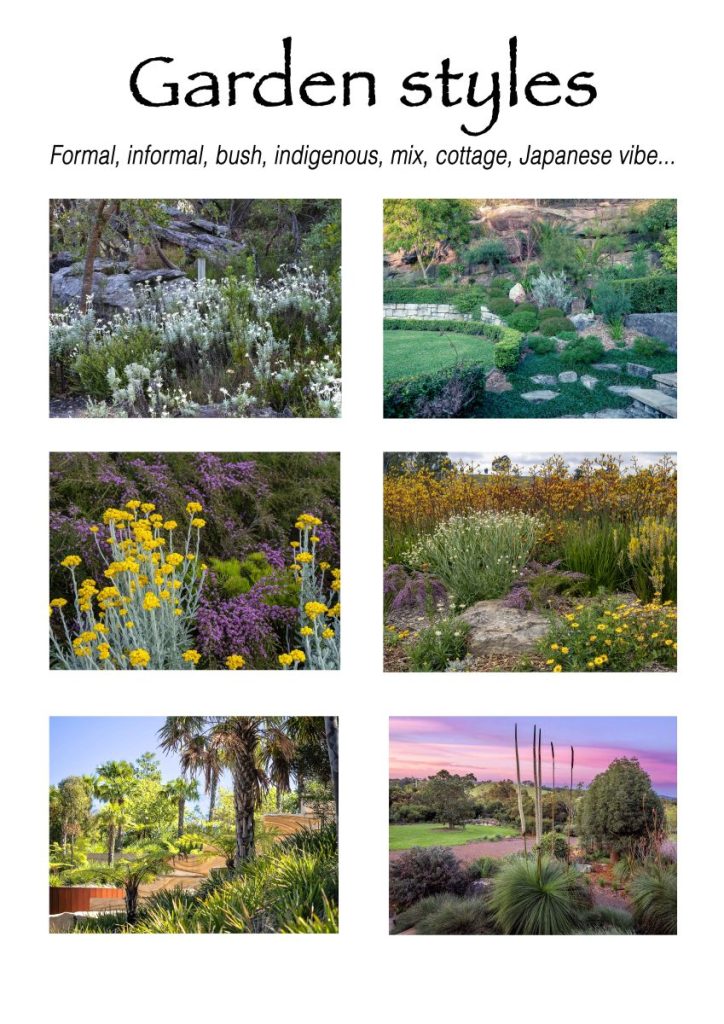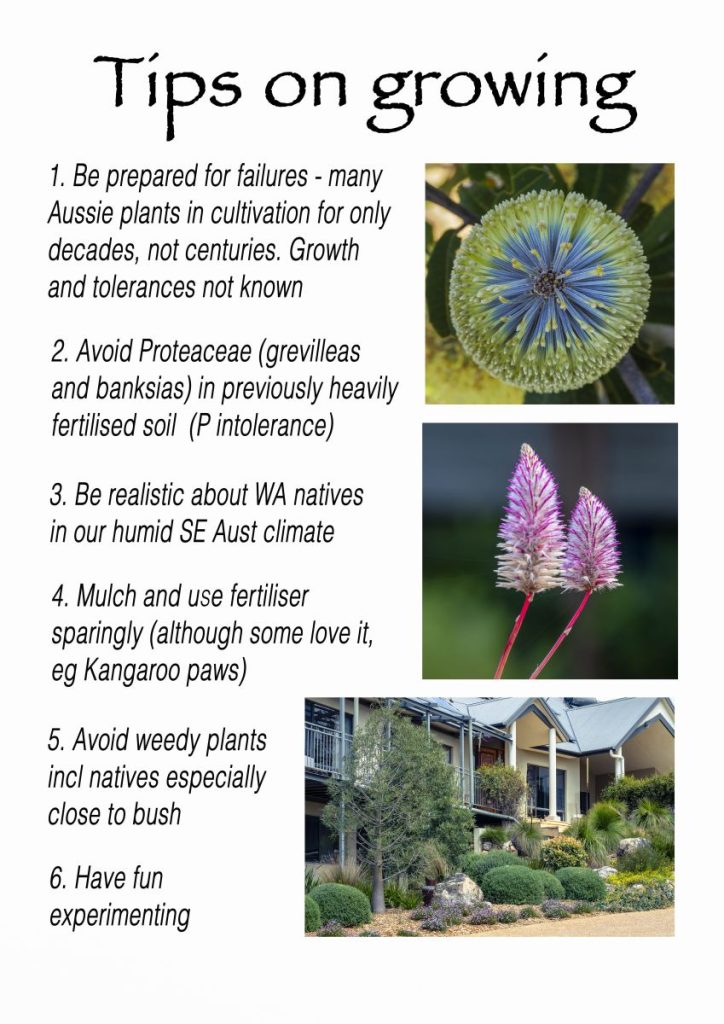I recently shared with a local garden club my passion for native plants – why grow natives and the best way to go about it. In particular, how do we introduce natives into an existing garden and what are the traps to be aware of.
Instead of a powerpoint presentation and screen, I produced half a dozen big posters of my talk to share with the group. Supported by a stunning bunch of flowers from Brian Roach’s garden, as well as some healthy tubestock to sell, we had a good discussion.
My passion for gardening came from my mum, who got us all out in the garden every month or so doing the weeding. And I’ve grown gardens wherever I lived – Melbourne, New Zealand, Central Coast and Sydney.
So why grow natives?

- Unique – about 90 million years ago, Australia split off from Gondwana. That means that our plants have been relatively isolated from those of the rest of the world for that time. That’s 90 or so million years of evolution of our flora. It means many of our plants are highly unique and not found anywhere else in the world. As custodians of the land, it seems we have a responsibility to protect and conserve these unique plants. Of course, they are also incredibly beautiful.
- Conserve fauna – our native flora exist in a mutually beneficial relationship with our fauna – its insects, birds, spiders, reptiles and other creatures. This relationship is essential for every ecosystem and the survival of the planet, including ourselves. When we plant native plants, we are helping create a healthy connection between plants and animals and save our unique fauna as well.
- Land clearing – in NSW, the last 10 years or so has seen unprecedented land clearing, native forest clearing. Some clearing is inevitable, but as it states in the NSW State of the Environment 2021 report: Permanent clearing of native woody vegetation in NSW has increased about three-fold since 2015 and stands at an average of 35,000 ha cleared each year. Permanent clearing of non-woody vegetation, such as native shrubs and ground covers, occurs at an even higher rate (
- Ecosystems under threat – due to climate change and other pressures on the environment, many of our ecosystems are under threat and may collapse. Higher temperatures, changing climate patterns, clearing, weeds, diseases etc – now is the time to protect these ecosystems (2021 State of the Environment Report ).
- Sustainability – our plants have evolved to cope with our poor nutrient soils and variable weather. Extra water and fertiliser are nice but not essential. By planting natives, we are reducing our resource use and so living a more sustainable life.
What kind of garden can I create?
The bush garden was popular through the 1970s and 1980s, as an early expression of native gardening. Now we know that you can have ANY garden design with natives – formal, informal, highly structured or cottage-y. Everything is up for grabs.
The fundamentals of garden design as relates to planting is that you need ground covers, low shrubs, medium to high shrubs and trees, as well as vines. In Australia we have ALL of those available amongst our plant species. The gardens we design are only limited by our imagination.
Here is a range of different styles to suit your needs.
- Bush style garden – ideal if you prefer to let nature have its way. Here the garden emulates nature, there are minimal man-made structures, paths or grassy areas. Plants are rarely pruned and the plants grow to their natural size and shape.
- Formal garden – these gardens can also be created with native plants. The planting at Horse Island by Christina Kennedy, and the one in the image to the right with a Japanese vibe are all formal in style. These gardens tend to have symmetrical shapes, clear edging, pruned plants and mass planting.
- Informal garden – probably the most common, informal gardens are more relaxed often with elements of both formal and bush gardens. Here, colour, shape and texture are important, paths are more sinuous and colours less constrained. At the Australian Botanic Garden Mt Annan each spring, there is a riot of colour and meadow like planting, which is a must see, along with the other displays all year round. The garden at Barangaroo uses only indigenous plants – those found in the area 200 years ago. The last pic on the right is my garden in the Hunter Valley and is an informal garden. I overplant as I hate weeding, and while there are some losses with competition, I enjoy the lushness of a full garden. There are always surprises. We are on a hill (400m) with heavy clay soil and vicious winds, so resilience is key.
Our national body of native plant enthusiasts, ANPSA, runs study groups focused on particular plant species and topics. Information about the Garden Design study group and past newsletters and resources are found there.

What plants?
With 24,000 to choose from, your choices are fairly limitless, although not all are in cultivation. Many plant families are represented and here is a small example of some of the really beautiful plants that are regularly seen in gardens.
I love the pea flowers for their colour and enrichment of the soil. The range of grevilleas blows the mind from low ground covers to trees. And of course there are many more! Our website has a link to some of the best native nurseries around NSW.
To search for more plants suitable for your garden, our searchable plant database has 1000 profiles and cultivation notes. You can search by name, or by plant size. See here for this free resource, developed by our passionate volunteers – Plant database.
Tips for growing
Be prepared to experiment!
- I joked with the group that I have an Excel spreadsheet with the thousand or so plants I’ve put in. But there’s another section of the spreadsheet, called ‘Died’. Oh well.
Many native plants have not been in cultivation all that long (years rather than decades or centuries), so growth and tolerances are not known. It’s all about trying things out. - Our grevilleas and banksias will not be happy in previously heavily fertilised soils, (they don’t like the high Phosphorous) so avoid direct planting. Roses followed by grevilleas just mightn’t cut it.
- Our Western Australian compatriots are appropriately proud of their flora. But be aware that WA is a Mediterranean climate (rain in winter), whereas east coast is summer rain and so these beautiful plants can suffer from root rot and so on. Put in these plants by all means, but treat them as annuals rather than expecting 20 years of growth. The best plants for our area are those that are local to the area.
- Mulch with hardwood chip – big chunky stuff that lets the moisture through and protects the plants from high temperatures. And only fertilise (low P please).
- Ensure the plants you put in are not weedy natives. There are a few of them – in my region, Pittosporum undulatum grows naturally, but it is weedy elsewhere in the country and ditto with some of the wattles. This is particularly relevant if you are near bush.
For more tips and information on growing native plants and gardens, see our Information section on our website. There are a range of searchable topics including gardening, identifying and conserving native plants.
Now have some fun. Be a pioneer for native plant growing and you will get plenty of rewards as all the birds and little critters flock to your garden!

